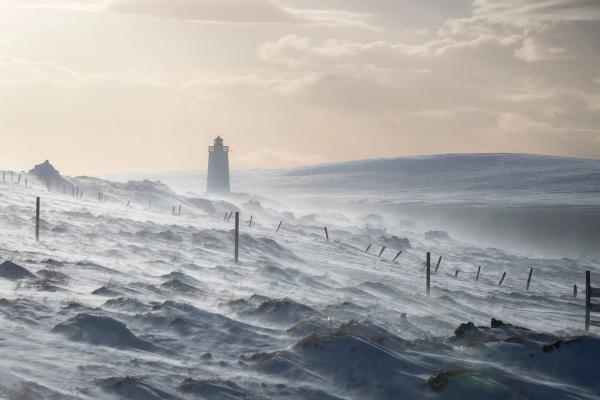
What to Expect: The Wind in Iceland
Iceland’s natural beauty is breathtaking, but the unpredictable weather can take you by surprise. One of the biggest factors to be aware of is the wind. Whether you're driving, hiking, or just soaking in the scenery, the wind can play a huge role in shaping your experience. From strong gusts along the southern coast to winds that can literally push cars off the road, understanding Iceland’s wind patterns is crucial for a safe and enjoyable trip.
Key Takeaways
- Iceland’s location between two oceans and the North Atlantic jet stream causes many storms and strong winds.
- The land makes the wind stronger, with gusts near glaciers and mountains, especially along the south coast.
- Wind changes with the seasons, with the strongest winds in winter and calmer weather in summer.
- Wind can affect travel, making driving, outdoor activities, and flights tricky, so it's important to check forecasts and pack windproof clothes.
Why Is Iceland So Windy?
Iceland is known for its windy conditions, and that’s mostly because of where it’s located. It sits between the Arctic and Atlantic Oceans, right in the path of the North Atlantic jet stream, which brings powerful low-pressure systems through the country. These systems, often referred to as the Icelandic Low, are responsible for frequent storms and high winds.
The landscape also plays a big role in the wind’s intensity. Winds tend to pick up as they sweep over mountains and glaciers. For instance, katabatic winds, which are driven by gravity, rush down from glaciers like Vatnajökull and Öræfajökull, creating powerful gusts in lower areas. You also get Foehn winds, which are warm, dry winds that come down the leeward side of mountains. These can lead to sudden, strong gusts, especially along the Snæfellsnes Peninsula and the southern coast.

Wind Speeds in Iceland and Dangerous Gusts
Understanding how to interpret Icelandic wind speeds is key to staying safe. In Iceland, wind speeds are measured in meters per second (m/s), and anything above 20 m/s (about 45 mph) is considered dangerous. During winter storms, it’s not unusual for gale-force winds to reach over 70 mph, especially along the southern coast and in the Vestfjords.
The windiest areas include the open plains along the south coast, the highlands, and regions near glaciers like Vatnajökull. Lómagnúpur is particularly notorious for sudden, powerful gusts that can even knock people off their feet. In these high-wind areas, it’s essential to keep a close eye on the wind forecast. The Icelandic Meteorological Office often issues "yellow alerts" or higher when the winds are expected to become hazardous.

Monthly Breakdown of Wind Patterns
The wind in Iceland varies a lot from month to month and season to season.
January – March: Strong, Stormy Winds
These are the stormiest months of the year in Iceland. Powerful winds sweep across the country, with the south coast bearing the brunt of it. Winds often exceed 50-60 mph during storms, and gale-force winds are a regular occurrence. When you combine the wind with snow, you can end up with near-blizzard conditions, especially in exposed areas.
April – June: Calmer Periods with Occasional Gusts
Spring brings a bit of relief from the strong winds, but you still need to stay cautious. April can still be windy, but by May and June, the winds tend to calm down a bit, especially in sheltered areas like the East Fjords. However, gusts can still surprise you, so it’s important to remain prepared.
July – September: Milder Winds with Gusty Days
Summer is the best time to visit if you want to avoid the worst of the winds. Wind speeds are generally lower, making it ideal for hiking and road trips. That said, you can still get gusty days, particularly near the highlands and glaciers, where katabatic winds can catch even the most experienced travelers off guard.
October – December: Increasing Winds as Winter Storms Return
By October, the winds start picking up again as autumn storms roll in. Driven by the North Atlantic jet stream, these storms bring frequent high winds, especially to the southern coast and mountainous areas. November and December see intense storms, with wind speeds exceeding 70 mph in some regions, particularly around Vatnajökull.

How Wind Affects Travel in Iceland
The wind in Iceland doesn’t just add to the dramatic atmosphere—it can seriously impact your travel plans.
Driving in Windy Conditions
Strong winds, particularly in the south and on open roads, can make driving dangerous. If you're in a campervan or a tall vehicle, the risks are even higher. Gusts along the Ring Road, especially near places like Lómagnúpur or the Vestfjords, can push vehicles off course. In some cases, winds over 50 mph have been known to rip car doors off if you’re not careful. Always check wind speeds, and when opening car doors in strong winds, be extra cautious.
Outdoor Activities
If you're hiking or sightseeing, the wind can really make a difference. In places like Þórsmörk, strong winds can cause wind erosion, making some paths unstable. If you're hiking in the Highlands or near glaciers, be ready for Arctic winds that cut through layers and can leave you feeling much colder than the temperature suggests. Camping is still possible, but make sure to pick a sheltered spot and use heavy-duty stakes to secure your tent in the wind.
Flight Disruptions and Travel Delays
The wind can also mess with your travel plans if you're flying. High winds, especially in areas like Húsavík, can cause flight delays or even cancellations. If you're flying within Iceland or arriving from another country, it’s a good idea to keep an eye on weather alerts from the Icelandic Meteorological Office.

Tips to Navigate the Wind in Iceland
The wind won't ever make you have to cancel your trip to Iceland, but it's good to consider it and act accordingly. Here are some tips to navigate the wind here.
Pack Windproof Clothing
Iceland’s wind can make it feel much colder than the actual temperature. Wind chill is no joke! Always pack a good windproof jacket, solid footwear, and gloves. If you're camping, make sure you have a tent that can handle strong winds, and secure it properly with heavy-duty stakes.
Check the Weather Regularly
The wind in Iceland can change rapidly. Before you head out for the day, make sure to check the Icelandic Meteorological Office's wind forecast. If you see wind speeds above 40 mph, adjust your plans to avoid potential hazards.
Be Careful with Outdoor Activities
Whether you’re hiking, camping, or just walking along a cliff, always be mindful of strong gusts. Areas like the Highlands or Vatnajökull can experience powerful winds that can turn what seems like an easy hike into something much more challenging.
Conclusion
The wind is an essential part of Iceland’s weather and landscape. From fierce winter storms to the milder breezes of summer, understanding the wind in Iceland will help you plan your trip better. Whether you're driving, hiking, or camping, staying informed about wind conditions will ensure you can explore Iceland's wild beauty safely.

